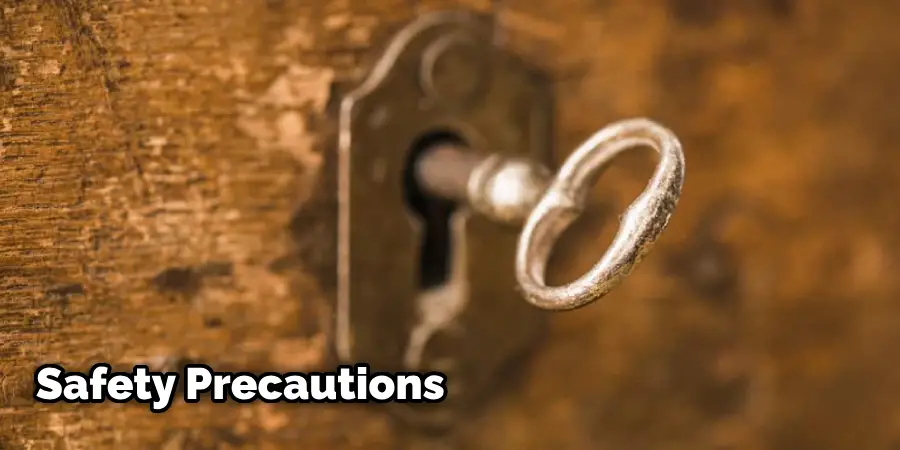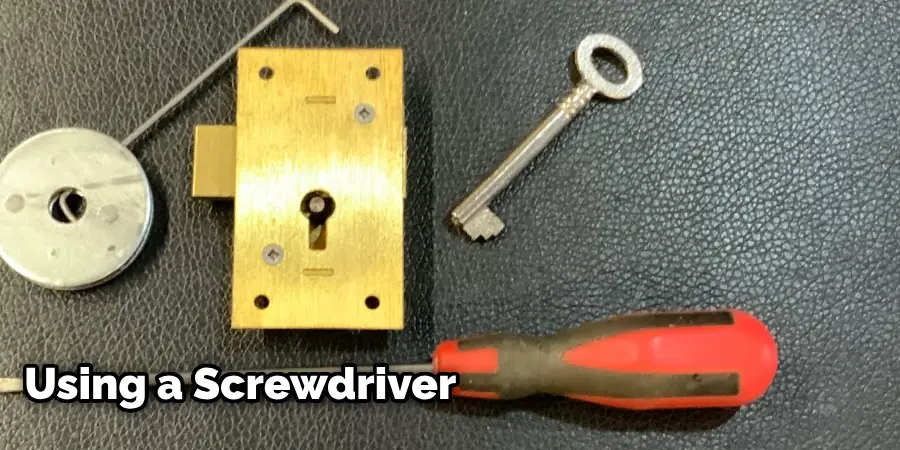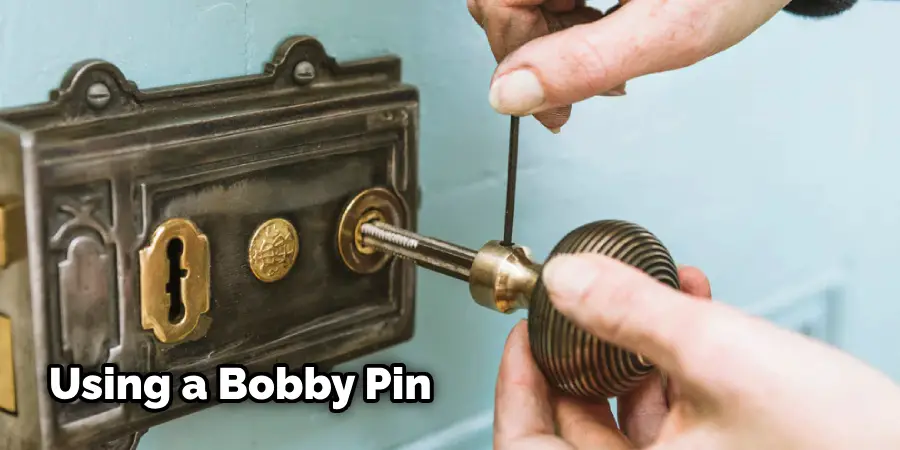Do you have an old drawer that has a lock, but you don’t have the key to open it? Are you curious about what lies inside but unable to gain access without damaging the furniture or lock?

Then worry no more! In this comprehensive blog post, we will explain step-by-step how to open old drawer lock without key safely and effectively.
Read on for surefire methods that require minimal effort so that with just a few simple steps, you can unlock any hard-to-open drawers and enjoy their contents in no time.
Understanding Old Drawer Locks
Before attempting to open a locked drawer without a key, it’s crucial to understand the different types of drawer locks that you may encounter.
A. Overview of common types of old drawer locks
1. Pin Tumbler Locks
Pin tumbler locks are the most common type of locks found on old drawers. These locks use a set of pins to prevent the lock from opening unless the correct key is inserted.
2. Wafer Locks
Wafer locks, on the other hand, use a set of flat, rectangular ‘wafers’ to prevent the lock from opening without the right key. They are relatively easy to pick with the right tools and techniques.
3. Tubular Locks
Tubular locks, which are often found on vending machines and bike locks, are more complex. They have a circular keyway and a circular key, making them more difficult to pick.
B. Importance of identifying the lock type for effective opening
Identifying the type of lock you’re dealing with is an essential first step in successfully opening a locked drawer without a key. The lock type determines the tools you’ll need and the techniques you’ll use to pick the lock. Armed with this knowledge, you can approach the task with confidence and increase your chances of success.
Preparing to Open the Drawer Lock
Before getting into the nitty-gritty of picking the lock, it’s important to prepare adequately. This preparation involves two steps: taking safety precautions and assessing the condition of the lock and drawer.
A. Safety Precautions

Your safety should always be the first consideration in any DIY project. Here are the necessary safety measures you should take:
1. Safety Goggles and Gloves
Always wear safety goggles and gloves when attempting to pick a lock. The goggles will protect your eyes from any flying debris, while the gloves will protect your hands from any sharp edges on the tools or the lock itself.
2. Proper Tools for Lock Manipulation
Using the right tools for the job is key to your safety and the success of your lock-picking attempt. Make sure you have the tools appropriate for the type of lock you’re dealing with. Improvising with inappropriate tools can lead to injury or damage to the lock or drawer.
B. Assessing the Condition of the Lock and Drawer
Before you start picking the lock, it’s important to assess the condition of the lock and the drawer.
1. Checking for Rust or Damage
Inspect the lock for any signs of rust or damage. A rusty or damaged lock can be more challenging to open and may require specialized tools or techniques.
2. Ensuring the Drawer is Stable and Won’t Be Damaged During the Process
Inspect the drawer itself to ensure it’s stable and won’t be damaged during the lock-picking process. If the drawer is fragile or already damaged, you may need to take additional precautions to protect it.
Traditional Methods on How to Open Old Drawer Lock without Key
Method 1: Using a Screwdriver

The simplest method to open an old drawer lock without a key is by using a screwdriver. This method works well for wafer locks and can also work for pin-tumbler locks with some modifications.
Step 1: Remove the Drawer
Remove the locked drawer from its slot in the furniture. This will give you more space to maneuver and access the lock.
Step 2: Locate the Lock
Locate the lock on the drawer. It’s usually located at the center of one of the sides or at the top or bottom of the drawer front.
Step 3: Insert Screwdriver into Keyhole
Insert a flathead screwdriver into the keyhole and push it as far as it will go. This will create enough space for you to turn the screwdriver and manipulate the lock.
Step 4: Turn the Screwdriver
Turn the screwdriver in a counterclockwise motion as if it were a key. You may need to apply some pressure while turning to mimic the action of a key.
Step 5: Pull the Drawer Open
As you continue to turn the screwdriver, you’ll feel the lock start to release. Once it’s fully disengaged, pull the drawer open.
Method 2: Using a Paperclip
If you don’t have a screwdriver on hand, a paperclip can also do the job of opening an old drawer lock without a key.
Step 1: Straighten Out Paperclip
Take a paperclip and straighten it out. You can use pliers to help you achieve a more precise shape.
Step 2: Insert Paperclip into Keyhole
Insert the paperclip into the keyhole, making sure to push it all the way in.
Step 3: Wiggle and Maneuver Paperclip
Wiggle and maneuver the paperclip inside the lock to try and mimic the action of a key. You can use a tension wrench or another small tool to apply pressure on the pins while manipulating them with the paperclip.
Step 4: Pull the Drawer Open
With some patience and trial-and-error, you should be able to manipulate the lock enough to pull open the drawer.
Method 3: Using a Bobby Pin

A bobby pin can also be used as an alternative to a paperclip in this method.
Step 1: Straighten Out Bobby Pin
Straighten out the bobby pin as much as possible, making sure it still has a slight curve at one end.
Step 2: Insert Bobby Pin into the Keyhole
Insert the curved end of the bobby pin into the keyhole, pushing it all the way in.
Step 3: Wiggle and Maneuver
Similar to the paperclip method, wiggle and maneuver the bobby pin inside the lock to try and mimic a key’s action.
Step 4: Pull the Drawer Open
With some patience and perseverance, you should be able to open the drawer with the bobby pin.
Method 4: Using a Knife
A knife can also be used to pick an old drawer lock without a key. This method is best for wafer locks and may require some modifications for pin-tumbler locks.
Step 1: Remove Drawer
As with previous methods, remove the drawer from its slot to give you more space to work.
Step 2: Locate the Lock
Find the lock on the drawer and insert the blade of the knife into the keyhole.
Step 3: Push Knife In
Push the knife in as far as it will go, making sure to apply pressure downwards.
Step 4: Wiggle Knife
Wiggle the knife back and forth to mimic a key’s motion. You may need to apply more pressure or adjust your angle to manipulate the lock successfully.
Step 5: Pull the Drawer Open
Once you feel the lock give, pull open the drawer.
Method 5: Using a Credit Card
Similar to picking a door lock with a credit card, you can also use this method to open an old drawer lock without a key.
Step 1: Insert Credit Card into Gap
Insert the edge of a credit card into the small gap between the drawer front and its frame. Make sure to insert it at the top or bottom, depending on where the lock is located.
Step 2: Push Downward
Push the card downward while simultaneously pulling the drawer handle towards you. This will help create enough space for the card to slide past the lock.
Step 3: Slide Card Out
Once the credit card is past the lock, slide it out and push on the drawer front to open it.
Method 6: Using a Jigsaw Blade
This method is best for wafer locks and may require some modifications for pin-tumbler locks.
Step 1: Remove Drawer
As with other methods, remove the drawer from its slot to give you more space to work.
Step 2: Insert Jigsaw Blade into the Keyhole
Insert a thin jigsaw blade into the keyhole of the lock. Make sure it’s inserted all the way in.
Step 3: Wiggle Blade
Wiggle the blade back and forth to mimic a key’s motion. You may need to adjust your angle or apply more pressure to manipulate the lock successfully.
Step 4: Pull the Drawer Open
Once you feel the lock give, pull open the drawer.
Method 7: Using a Drill
This method is best for wafer locks and may require some modifications for pin-tumbler locks.
Step 1: Remove Drawer
As always, remove the drawer from its slot to give you more space to work.
Step 2: Pick the Right Drill Bit
Select a drill bit that’s small enough to fit into the keyhole of your lock. You can also use a set of needle nose pliers to twist and turn the drill bit if you don’t have access to an actual drill.
Step 3: Insert Drill Bit
Insert the drill bit into the keyhole and start drilling. Make sure to go slowly and gently at first, increasing pressure as needed.
Step 4: Push Drawer Open
Once you feel the lock give, push on the drawer front to open it. You may need to use a flathead screwdriver or other tool to manipulate any remaining pins inside the lock.
By following these methods, you should be able to open an old drawer lock without a key successfully. Remember to use caution and always seek professional help if needed. Happy unlocking!
Troubleshooting Tips for Difficult Locks
If you encounter a particularly stubborn lock, here are a few troubleshooting tips that may help:
- Try using more pressure or adjusting your angle while manipulating the lock.
- Use lubricant or graphite powder to help ease the movement of the lock’s pins.
- If using a drill, make sure you have the correct size and type of drill bit for your specific lock. You may also need to use a different technique or tool depending on the type of lock.
- Take breaks when needed and approach the problem with patience and persistence.
Remember, picking locks without proper authorization is generally not recommended and may be illegal in some areas. Only use these methods for your locks or with the owner’s permission.
Conclusion
In conclusion, unlocking an old drawer without a key can seem like a daunting task, but these methods provide practical, step-by-step guides to do so with common household items. Whether you use a paperclip, bobby pin, credit card, knife, jigsaw blade, or even a drill, patience and precision are crucial. However, remember that these methods should only be employed ethically and legally. If you’re unable to open the lock despite trying these methods, it’s always best to consult with a professional locksmith. Lock-picking can be a useful skill, but it should always be employed responsibly.

